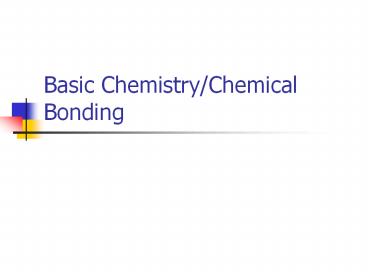Basic Chemistry/Chemical Bonding PowerPoint PPT Presentation
Title: Basic Chemistry/Chemical Bonding
1
Basic Chemistry/Chemical Bonding
2
DRAW WHAT YOU THINK AN ATOM LOOKS LIKE
3
Atoms are around us and in us
- World is made up of many different substances
- Chemistry tells us all different types of matter
that exists - Matteranything that takes up space (form of a
solid,liquid, gas) - Atoms? building blocks of matter
4
Atoms of one type are elements
- Atoms exist in the form of elements
- H hydrogen atoms make up hydrogen
- O oxygen atoms make up oxygen
- C carbon atoms make up carbon
- Clchlorine atoms make up chlorine
- Fe iron atoms make up iron
5
Main Elements in Biology
- H hydrogen Cl chlorine
- C carbon S sulfur
- N nitrogen
- O oxygen
- P phosphorus
- CHONPS
6
All the element are organized on the Periodic
Table
7
Structure of the atom (Subatomic Particles)
- Nucleus inside contains
- Protons(),neutron(0)
- Electrons outside
- Negatively (-) charged
8
Atomic Number and Mass Number for Elements
- The atomic number of protons or electrons
- Mass Number number of protons neutrons
Atomic Number
6
C
Mass Number
12.001
9
How To Determine the Number of Neutrons?
- Subtraction
- Mass Number- Atomic Number
10
How do elements combine?
- Elements combine by bonding
- Two Ways
- Covalent
- Ionic
11
Covalent Bonding
- Sharing of electrons in order to bond elements
- SharingCaring? COVALENT
- Found in the formation of H20, HCl
12
Ionic Bonding
- Electrons are donated/transferred in order for
bonding to occur - Results in ion charges
- Used in forming crystals (NaCl)
13
Compounds
- Most substances found in nature exist as
compounds - Compounds two or more different kinds of atoms
combined - Atom A Atom B Compound AB
- H2 O2 H20
- Other ex CO2, CaCl2, C6 H12 O6
14
Making of Hydrogen Molecule
15
Bonding of atoms to form H
16
Making of Water
17
Ionic Bonding of NaCl
18
Ionic Bonding of NaCl
19
WATER SCIENCE
- Water is a very important molecule in biology
- Our bodies are made up of A LOT of water
- Muscle 75
- Blood 95
- Fat 14
- Bone 43
20
Amazing Properties of Water
- Adhesive, Cohesive, Polar, Capillary Action
- Adhesive sticks to surface
- Cohesive sticks to itself
- Polar has both positive and negative charges
- Capillary Action can move against gravity
21
Why does water have these properties?
- It is a polar molecule
- Polar uneven distribution of charges
- H slight positive charge (2 of them)
- O slight negative charge (1 of them)
22
What does this allow for?
- Bonding of water to water through Hydrogen
Bonding - O of one water molecule is attracted to the H
from another water molecule - Its like a magnet
- Because of this, water can stick to itself, and
is able to stick to surfaces
23
Other Water Properties
- Hydrophobic water fearing
- Some biochemical molecules will stay away from
water because they are non-polar - Hydrophilic water loving
- Some biochemical molecules will be attracted to
water because they too are POLAR
24
Adhesive and Cohesive Properties
25
ADHESION COHESION
- Adhesion Cohesion
- SURFACE TENSION
26
Organisms can walk on water
27
This is why water sticks to the graduated cylinder
28
Magnified Graduated Cylinder
29
Mixtures
30
Suspensions
31
Solutions
32
Other Chemistry Info
- Mixture two or more compounds physically but not
chemically put together - Two Types solutions and suspensions
- Solutions type of mixture when parts are evenly
distributed when dissolved in water (e.g. Salt
in water and sugar in water, Kool-Aid) - Two parts? solutes (solid), solvent (what its
dissolved in) - Water is considered the universal solvent.
- Suspensions type of mixture where (solute)
material does not mix. ( sand in water, oil in
water)
33
(No Transcript)
34
Chemical Properties of Solutions
- Can be an acid or a base based on amount of
hydrogen (H) and hydroxide (OH) present once
dissolved in water - Acida solution that has a lot of H
- Base a solution that has a little bit of H
35
Measurement of Acids and Bases
- pH scales measure the percent of hydrogen present
- Acids are between 1-6 on the scale
- 1? highly acidic
- 6? slightly acidic
- Bases are between 8-14 on the scale
- 8?slightly basic
- 14? highly basic
36
pH scale
37
Indicators Used to Detect Acids or Basic
Substances
- Litmus paper? can be acidic or basic based
- Acidic substances turn litmus paperpinks/reds
- Basic substances turn litmus paper blues/violets
- Universal Indicators will change different
colors based on substance. Must use color chart
to determine pH value.
38
Chemistry Check Answer the following in complete
sentences
- Whats the difference between adhesion and
cohesion? - What makes water a polar molecule?
- A molecule that does not interact with water is
considered - A molecule that does interact with water is
considered - Solutions and suspensions are two types of
- A solution has a pH of 9. Is it acidic or basic?
- Two solutions are placed in front of you, one has
a pH of 5 and the other has a pH of 2, which has
a higher pH

